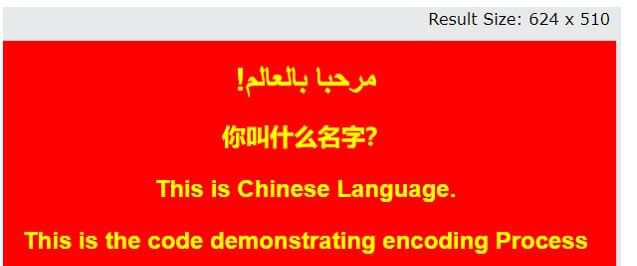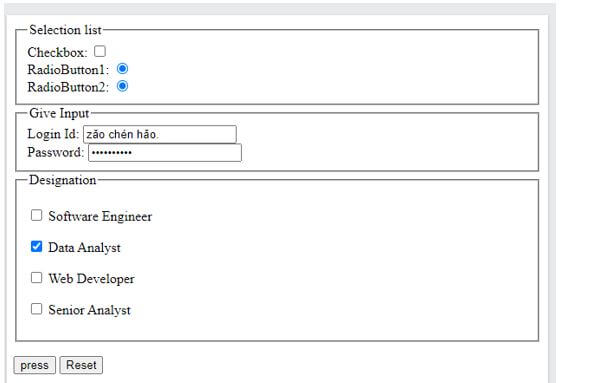UTF-8 in HTML
UTF-8 is defined as the default character encoding for HTML5 used to display an HTML page perfectly. It encourages web developers to use UTF-8 as it covers all the characters and symbols in the entity that uses one byte and works well in all the browsers. Unicode Transformation Format – 8 bits are a method converts typed character into machine-readable code. The charset attribute is used to perform a character encoding for the HTML.
Syntax of UTF-8 in HTML
Specification of UTF-8 Character encoding in the tag is given as:
1 |
|
Here meta gives data about the HTML document but is machine-readable. And their elements specify a keyword, last modified etc. This meta tag contains the charset, which tells the web browser while accessing the page.
Encoding is how the given numbers are converted to binary numbers, which a machine understood. Here each character is made up of one or more bytes respectively.
How does UTF-8 Works in HTML?
- The most popular encoding character is ASCII; as the internet grew up globally, the only supported Latin is not efficient; that’s why an industry moved on to Unicode as the best option. UTF-8 is the encoding for Unicode, which assigns a unique value called code point for all the characters and emojis. This encoding system solves the issue in ASCII space and is considered to be a dominant encoding for the W3C. And recommended that all e-mail messages could be created using UTF-8. This checks if the page explicitly declares as UTF-8 using a meta tag at the beginning of the document. The significant bit of UTF-8 is defined as 8,16, 24 or 32 bits as they are encoded as one to four bytes. UTF-8 is considered to be a global standard for existing applications as it understands more applications. This encoding helps to encode text and transfer data. UTF-8 encoding s most preferable on most websites. This standard covers all characters, symbols, punctuation all over the world.
- UTF-8 treats a range 0-127 as ASCII code and later up to 192 as shift keys. And the next characters, 224-239, has to be double shifted. Therefore, it is termed multi-byte variable encoding.
- Unicode assigns unique code to every character in a human language. The character set (Grouping all available characters into a specific set) could be overridden using the lang attribute. This Unicode translates into a Binary and vice-versa. It prevents unexpected results during form submission applications. UTF-8 should be considered when we find web pages are lagging inordinate amount of space. Storing UTF-8 text into a binary meanwhile char becomes binary, varchar shows to VARBINARY in SQL.
As an example, let’s take the text Hi, EDUCBA!
The UTF-8-character Encoding is given as below:
01001000 01101001 00101100 01100101 01000100 01010101 01000011 01000010 01000001 00100001
Which converts into a machine-readable binary structure.
Key Importance to Use UTF-8
- It is deliberately compatible with encoding standard ASCII.
- This preferred HTML encoding uses less space and supports many languages.
- This benefits the SEO. Suppose you use two standards, then it leads to a decoding issue that wrongly impacts the SEO. It means we need to implement the character correctly to Help SEO efforts.
Next, we shall see how the Unicode representation is important while taking up foreign languages in the content.
Examples of UTF-8 in HTML
Given below are the examples of UTF-8 in HTML:
Example #1
Simple example with the paragraph content.
Code:
new.html
1 2 3 4 5 6 7 8 9 10 11 12 13 14 15 16 17 18 |
|
Explanation:
- The screenshot below shows the content displayed in the Chinese language as well as in English. This is because when the above HTML code is executed in a modern Browser, it normally refers to Unicode.
Output:

Example #2
Using Buttons for the input text.
Code:
lang.html
1 2 3 4 5 6 7 8 9 10 11 12 13 14 15 16 17 18 19 20 21 22 23 24 25 26 27 28 29 30 31 |
|
Explanation:
- The screenshot below shows the input content displayed in the Chinese language as well as in English. This is because when the above HTML code is executed in a modern Browser, it normally refers to Unicode.
Output:

Example #3
Code using foreign-language content.
Code:
mett.html
1 2 3 4 5 6 7 8 9 10 11 12 13 14 15 16 17 18 19 |
|
Explanation:
- The above code uses the Spanish language to check the compatibility in the web browser.
Output:

Example #4
Using JavaScript.
Code:
name.js
1 2 3 4 5 6 7 8 9 10 11 12 13 14 15 16 17 18 19 20 21 22 23 24 25 26 27 28 29 30 31 32 33 34 35 36 |
|
Explanation:
- The above code uses functions to class the respective class. Before that, we have declared metadata for the encoding process. Here we have assigned an element with another language. Unfortunately, ASCII doesn’t have compatibility to access. Therefore, we have declared UTF-8 to support the type.
Output:

Conclusion
So that’s all about the encoding of UTF-8 in HTML. We have gone through Unicode and encodes in the HTML briefly and the implementation of HTML and JavaScript. In this emerging software world, the character sets are not made so feasible; therefore, there comes character encoding schemes to be done with the HTML and other programming languages. Therefore, it is said that it is best to use UTF-8 everywhere where it doesn’t need any conversions encoding.
The above is the detailed content of UTF-8 in HTML. For more information, please follow other related articles on the PHP Chinese website!

Hot AI Tools

Undresser.AI Undress
AI-powered app for creating realistic nude photos

AI Clothes Remover
Online AI tool for removing clothes from photos.

Undress AI Tool
Undress images for free

Clothoff.io
AI clothes remover

Video Face Swap
Swap faces in any video effortlessly with our completely free AI face swap tool!

Hot Article

Hot Tools

Notepad++7.3.1
Easy-to-use and free code editor

SublimeText3 Chinese version
Chinese version, very easy to use

Zend Studio 13.0.1
Powerful PHP integrated development environment

Dreamweaver CS6
Visual web development tools

SublimeText3 Mac version
God-level code editing software (SublimeText3)

Hot Topics
 1673
1673
 14
14
 1429
1429
 52
52
 1333
1333
 25
25
 1278
1278
 29
29
 1257
1257
 24
24
 Table Border in HTML
Sep 04, 2024 pm 04:49 PM
Table Border in HTML
Sep 04, 2024 pm 04:49 PM
Guide to Table Border in HTML. Here we discuss multiple ways for defining table-border with examples of the Table Border in HTML.
 Nested Table in HTML
Sep 04, 2024 pm 04:49 PM
Nested Table in HTML
Sep 04, 2024 pm 04:49 PM
This is a guide to Nested Table in HTML. Here we discuss how to create a table within the table along with the respective examples.
 HTML margin-left
Sep 04, 2024 pm 04:48 PM
HTML margin-left
Sep 04, 2024 pm 04:48 PM
Guide to HTML margin-left. Here we discuss a brief overview on HTML margin-left and its Examples along with its Code Implementation.
 HTML Table Layout
Sep 04, 2024 pm 04:54 PM
HTML Table Layout
Sep 04, 2024 pm 04:54 PM
Guide to HTML Table Layout. Here we discuss the Values of HTML Table Layout along with the examples and outputs n detail.
 HTML Input Placeholder
Sep 04, 2024 pm 04:54 PM
HTML Input Placeholder
Sep 04, 2024 pm 04:54 PM
Guide to HTML Input Placeholder. Here we discuss the Examples of HTML Input Placeholder along with the codes and outputs.
 How do you parse and process HTML/XML in PHP?
Feb 07, 2025 am 11:57 AM
How do you parse and process HTML/XML in PHP?
Feb 07, 2025 am 11:57 AM
This tutorial demonstrates how to efficiently process XML documents using PHP. XML (eXtensible Markup Language) is a versatile text-based markup language designed for both human readability and machine parsing. It's commonly used for data storage an
 HTML Ordered List
Sep 04, 2024 pm 04:43 PM
HTML Ordered List
Sep 04, 2024 pm 04:43 PM
Guide to the HTML Ordered List. Here we also discuss introduction of HTML Ordered list and types along with their example respectively
 HTML onclick Button
Sep 04, 2024 pm 04:49 PM
HTML onclick Button
Sep 04, 2024 pm 04:49 PM
Guide to HTML onclick Button. Here we discuss their introduction, working, examples and onclick Event in various events respectively.




